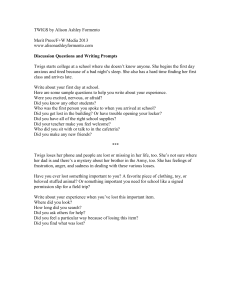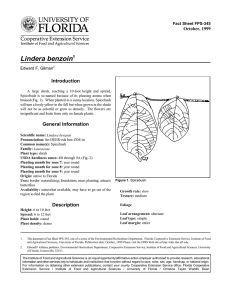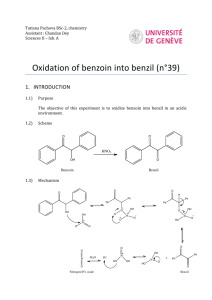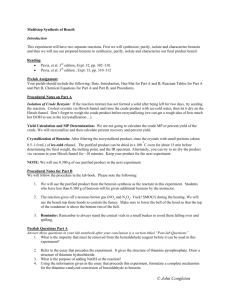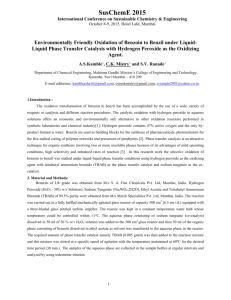Lindera benzoin Spicebush Kasey Hartz Natural Area Reference Sheet
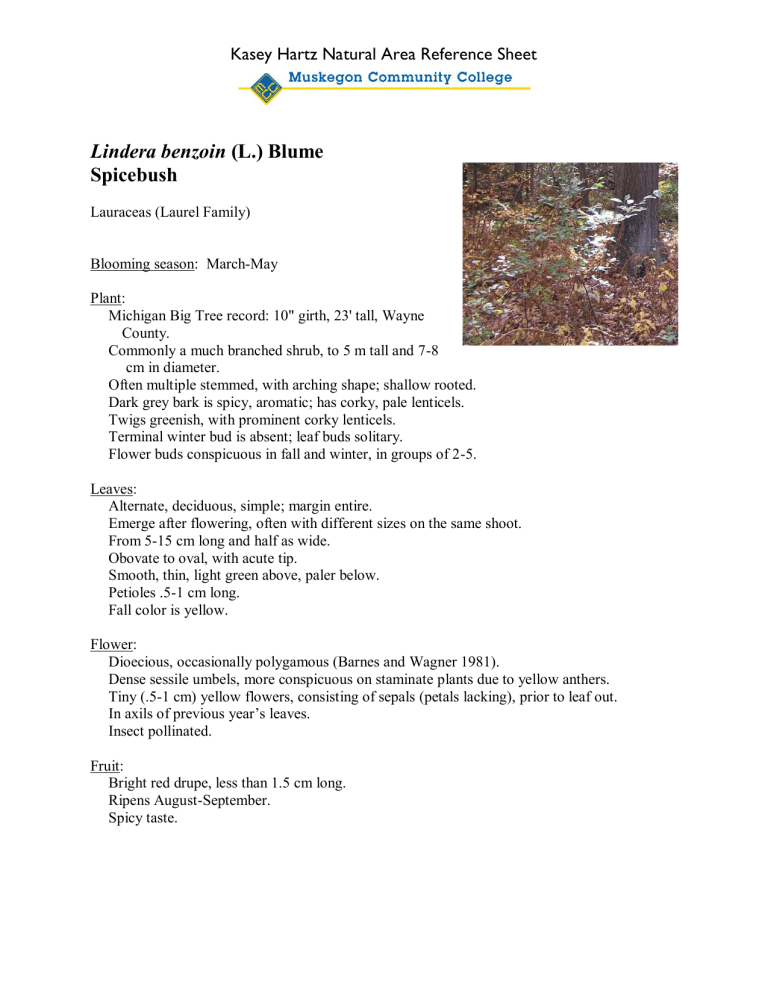
Kasey Hartz Natural Area Reference Sheet
Lindera benzoin (L.) Blume
Spicebush
Lauraceas (Laurel Family)
Blooming season: March-May
Plant:
Michigan Big Tree record: 10" girth, 23' tall, Wayne
County.
Commonly a much branched shrub, to 5 m tall and 7-8
cm in diameter.
Often multiple stemmed, with arching shape; shallow rooted.
Dark grey bark is spicy, aromatic; has corky, pale lenticels.
Twigs greenish, with prominent corky lenticels.
Terminal winter bud is absent; leaf buds solitary.
Flower buds conspicuous in fall and winter, in groups of 2-5.
Leaves:
Alternate, deciduous, simple; margin entire.
Emerge after flowering, often with different sizes on the same shoot.
From 5-15 cm long and half as wide.
Obovate to oval, with acute tip.
Smooth, thin, light green above, paler below.
Petioles .5-1 cm long.
Fall color is yellow.
Flower:
Dioecious, occasionally polygamous (Barnes and Wagner 1981).
Dense sessile umbels, more conspicuous on staminate plants due to yellow anthers.
Tiny (.5-1 cm) yellow flowers, consisting of sepals (petals lacking), prior to leaf out.
In axils of previous year’s leaves.
Insect pollinated.
Fruit:
Bright red drupe, less than 1.5 cm long.
Ripens August-September.
Spicy taste.
Kasey Hartz Natural Area Reference Sheet
Lindera benzoin (L.) Blume
Spicebush 2
Can be confused with: Spicy taste and fragrance can be compared with and easily differentiated from sassafras ( Sassafras albidum [Nutt.] Nees). The light colored corky lenticels on the grey bark, absence of terminal leaf buds, and 3 bundle scars assist in identifying. The leaves of alternate leaved dogwood ( Cornus alternifolia L. f.) have veins following the margins, rather than aiming for the edge.
Geographic range:
Type specimen location:
State: Southern half of Lower Peninsula.
Regional: Southern Ontario, Maine, south to Florida and west to Kansas and Texas.
Habitat:
Local: Creek area.
Regional: Rich deciduous woods, swamp forests, fertile soils. Tolerates high water table, but can grow in somewhat dry conditions.
Common local companions:
Elderberry, red maple, skunk cabbage, and even invasive barberry.
Usages:
Human: Native Americans used the berries as seasoning, either dried and ground or fresh; the leaves, which contain camphor, were used as an insect repellant. They made the twigs into a tea used for menstrual pain, and to bring on the menses. Other teas were used: as a vermifuge; for coughs and colds; and as an emetic. These uses were learned by the colonists, who also made a tea from the leaves, twigs, and bark to be used as a social drink.
This species is not the source of the benzoin of the drug trade, which comes from Styrax sp.
Other animal: Insects are required for pollination. Both the green-clouded swallowtail butterfly and the promethea moth use this as a nursery plant. The fruits are eaten by birds and the twigs by white-tailed deer, cottontails, opossum, ruffed grouse, and various songbirds.
Why is it called that ? Lindera is for Johann Linder, a Swedish botanist and physician who lived from 1676 to 1723. Benzoin is from “an Arabic vernacular word meaning aromatic gum” (A.W.
Smith 1997, p. 58). It is called spicebush both from earlier uses as a spice, and for its spicy aroma and taste.
Prepared by: Barbara Lukacs Grob, April 2008
